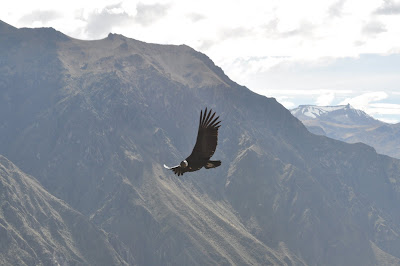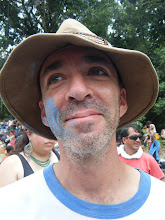Having left the drama in Puno, we find ourselves in Arequipa, which I will write about in my next post. The most common tour from Arequipa is to go to Colca Canyon to see condors and nature. There are numerous tour agencies in town selling one, two and three day tours. We talk to some agencies, but the tours do not sound fun and contrived. We decide that we will do it ourselves which is a fairly easy option.
We take a long bus ride through Salinas y Aguada Blanca national park with beautiful mountain views, vicuña spotting and herds of alpaca. This is the one of the few points I find bad about not doing tours is that when on public transportation you cannot stop at interesting viewpoints or small towns for a quick look. Everything whizzes by seen through the bus glass window. If we do get off in a random place like the middle of a national park we better make sure beforehand that there is other transportation coming.
 |
| Alpaca Crossing as seen through a dirty bus window |
We skip Chivay, a town with a cement hot springs pool and over-priced tourist buffets on everyone's tour list and go straight to Cabanaconde. Cabanaconde is the closest town to the condor viewing point and the trails heading down to an oasis at the bottom of the canyon. At 3,191 m (10,469 ft) Colca is one of the deepest canyons in the world. And we are going to walk down to the bottom. Some perspective for my American comrades... it's twice the depth of the Grand Canyon.
 |
| If you can make out the little blue spot near the bottom of this photo that is our destination |
The first hotel we check is off to the right from the trail. It is not so nice. The cabana is thatched with dirt floor a bed and table. Garbage is not picked up around the grass. It just feels dumpy, but I am too tired to even want to think about walking anymore. Mika really cannot imagine that anyone would make all this effort to hike down this huge canyon just to stay here so we move on and find a cheap, new little place. The next day instead of going up the canyon to sleep in Cabanaconde again we move hotels to spend one more night below. This place has nice cabanas with stone floors, a large pool built in between two giant boulder and a trail leading to the river.
 |
| At the very bottom of the canyon: Zen art rock sculptures are a popular thing to do around Colca |
 |
| The limited sky views from inside the canyon is slightly claustrophobic like being in an aquarium with painted sides |
I Think I Can, I Think I Colca Canyon Can
Any way you look at it the thought of going back up the canyon is daunting. Even the ever optimistic Little Engine That Could would be seriously doubting himself. But as we all know, 'what goes down must come up' including us sitting at the bottom of one of the deepest canyons on the planet. Just two options: we can either go straight up the way we came or choose the circuitous route.
If we choose the round about way it means that we have to walk up half way to one village, cross over to another village, down again to a third village at the very bottom of the canyon, and then an arduous 4-6 hr hike all the way back up to Cabanaconde. I am good to go, but Mika balks at this plan and chooses the lesser of two evils - climbing back up the trail we came.
 |
| What goes down must come up |
We soon see flashlights below of groups starting their hike. I do have to say that from all the volcanoes and such I have conquered and have been conquered by (see Baños and Quilotoa posts), I think that I am in pretty good hiking shape and can move faster than most others on the trail. The same cannot be said for Mika. She is dragging early and soon passed by others. When light comes in I move on ahead and can actually spot her about five switchbacks down from me. Suddenly I remember that I am carrying the food so must wait...and wait. We have a long break as the sun finally rises over the mountains and starts to warm the canyon. We then slog on together.
 |
| She'll be coming around the mountain when she comes |
 |
| See you at the top |
The Flight of the Condors
The main activity around Colca has to be Andean condor watching. There is one point, Cruz del Condor, where it is possible to get great glimpses of the world's largest flying bird. There are two viewpoints that sit on the edge of a cliff and condors can be seen from a great distance flying below and above. They start early in the morning and then around 9:00 am leave to go find food for the day. I am told that these eat dead donkeys and horses. But how many dead equine can there be in the area to support a healthy condor population?
We end up going twice to see the condors. Once really early before the tourist rush and the next time later in the morning to catch the condors at their peak flying time. The first time we go to the point we arrive at 6:30 am. It is very peaceful with only eight tourists here, but windy. Condors are soon spotted, but like us they are cold and waiting for the sun to warm them up. Two are perched for awhile within very good viewing distance while a few others are flying about. Actually, I hardly ever see condors fly. They glide like giant paper airplanes on the wind streams for long distances without almost ever flapping their wings. It is very elegant for what is essentially a 'fancy vulture.'
As the morning hour lengthens handicraft sellers begin arriving and setting up their wares. By 7:30 AM the group buses start to show up and by 8:00 AM the tourist circus is full on with many people coming and going. 9:00 AM is when the condors get most active. There must be twenty of them and some are making what seems like very close passes over the heads of the people.
By 9:30 AM most of the condors - surely disappointed that none of the camera-toting mammals are dead - have gone off to look for breakfast. By 10:00 AM the tour buses have disappeared and the handicraft sellers have packed their bags and are waiting for their buses back to their villages. We hop on the 10 AM bus and make the long journey back to Arequipa.
 |
| Take a shopping break while condor watching |
*Since there is no waste disposal system it is suggested that you carry all of your garbage out of the canyon because if you don't it will just get dumped somewhere in the canyon. As good citizens we brought everything all the way back to Arequipa.
** Mule rides can be arranged to ride all the way up or down the canyon. Some tour groups use mules to carry their backpacks and food which is then waiting for them when they arrive at the oasis.


















Colca Canyon is a wonderful place for tourists.This is also true the it is a hilly area and one has to walk so long otherwise animals are used to carry peoples
ReplyDeleteThanks for the comment Dacey. Glad you appreciate the beauty of Colca.
ReplyDeleteReally a very nice place for tourism.These rocky mountain and hilly areas attracts people to this place.I really love to visit this place.
ReplyDeleteYou're right Maria. It really is great. It will probably get more and more popular as tourism to Peru grows.
ReplyDeleteThanks for the comment.